Social Work Case Study: Systems Theory Application for Elderly Couple
VerifiedAdded on 2020/05/03
|16
|5280
|580
Report
AI Summary
This report analyzes a social work case study involving an elderly couple, Leo and Rachel, who are facing challenges due to Leo's Huntington's disease. The paper applies Systems Theory to guide the assessment and intervention process, examining the couple's interactions within their family system and their environment. It explores the core elements of Systems Theory, including holistic approaches, boundaries, social change, and circular causality, to understand how these concepts can be applied to the case. The assessment process involves understanding the communication patterns, the family's response to stress, and the resources available to them. Intervention strategies, such as conflict resolution, addressing undesirable behavior, and fostering self-esteem, are discussed. The report highlights the importance of a social worker's interpersonal skills and the need for a person-centered approach to improve the couple's emotional well-being and quality of life.
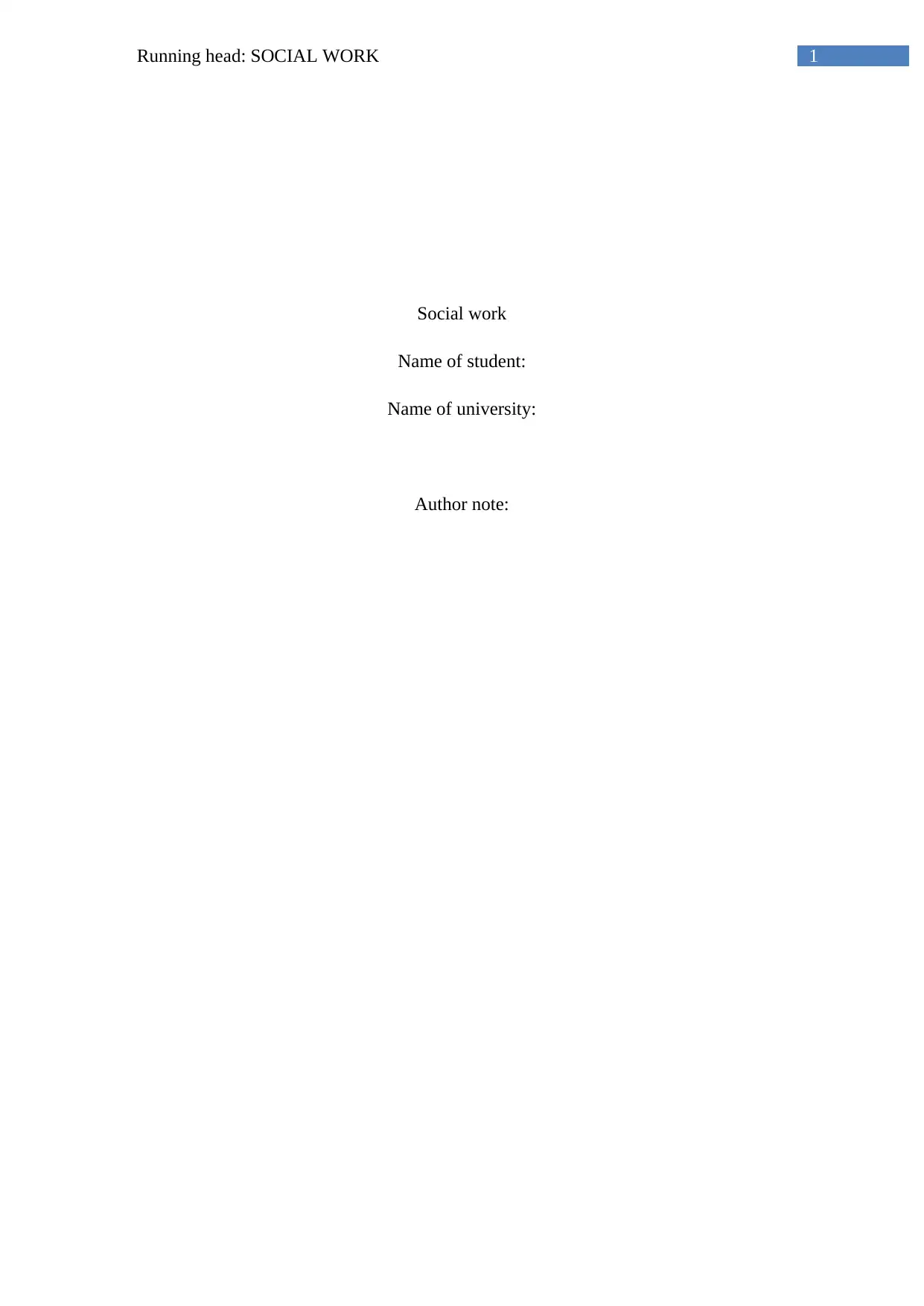
1Running head: SOCIAL WORK
Social work
Name of student:
Name of university:
Author note:
Social work
Name of student:
Name of university:
Author note:
Paraphrase This Document
Need a fresh take? Get an instant paraphrase of this document with our AI Paraphraser
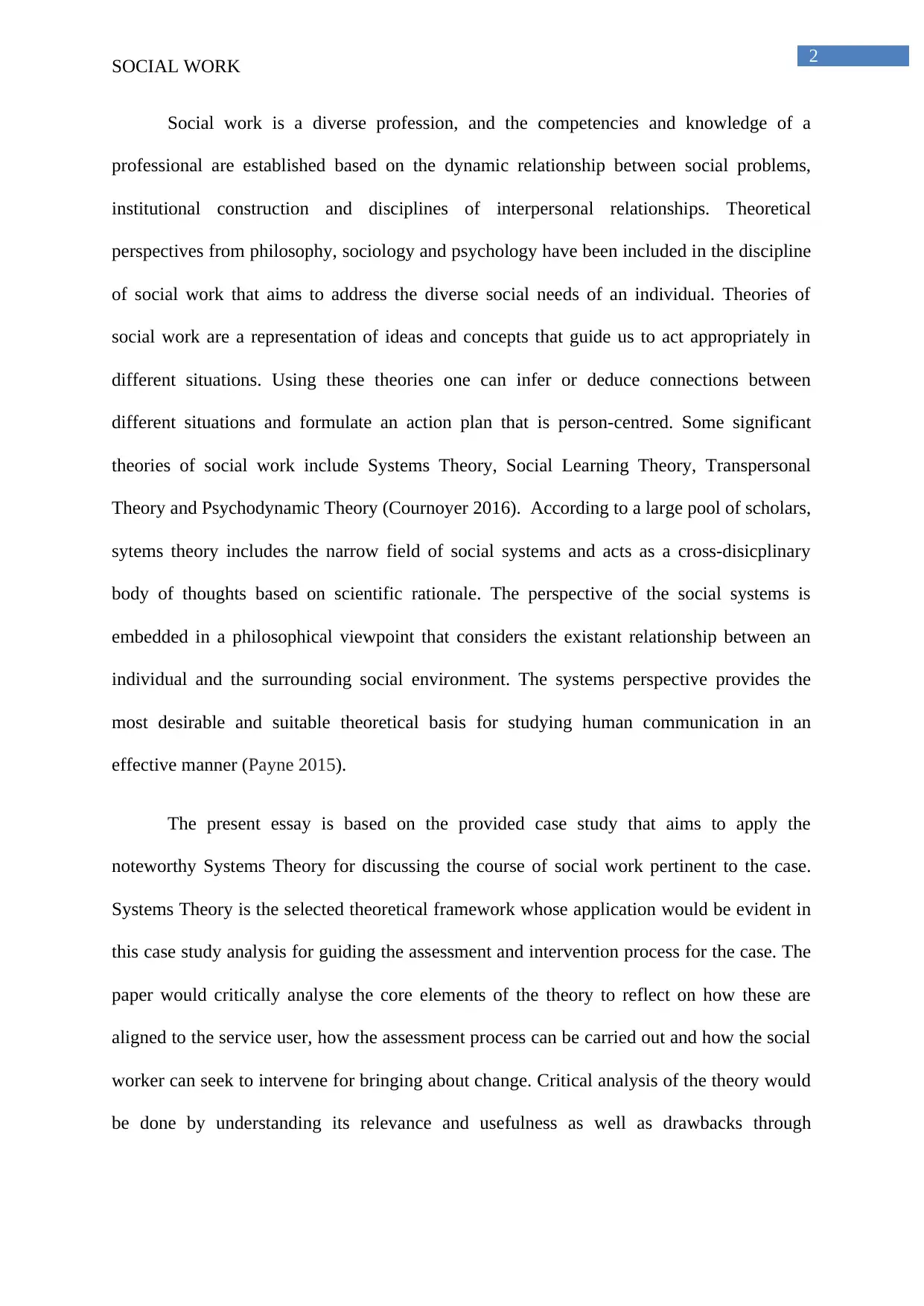
2
SOCIAL WORK
Social work is a diverse profession, and the competencies and knowledge of a
professional are established based on the dynamic relationship between social problems,
institutional construction and disciplines of interpersonal relationships. Theoretical
perspectives from philosophy, sociology and psychology have been included in the discipline
of social work that aims to address the diverse social needs of an individual. Theories of
social work are a representation of ideas and concepts that guide us to act appropriately in
different situations. Using these theories one can infer or deduce connections between
different situations and formulate an action plan that is person-centred. Some significant
theories of social work include Systems Theory, Social Learning Theory, Transpersonal
Theory and Psychodynamic Theory (Cournoyer 2016). According to a large pool of scholars,
sytems theory includes the narrow field of social systems and acts as a cross-disicplinary
body of thoughts based on scientific rationale. The perspective of the social systems is
embedded in a philosophical viewpoint that considers the existant relationship between an
individual and the surrounding social environment. The systems perspective provides the
most desirable and suitable theoretical basis for studying human communication in an
effective manner (Payne 2015).
The present essay is based on the provided case study that aims to apply the
noteworthy Systems Theory for discussing the course of social work pertinent to the case.
Systems Theory is the selected theoretical framework whose application would be evident in
this case study analysis for guiding the assessment and intervention process for the case. The
paper would critically analyse the core elements of the theory to reflect on how these are
aligned to the service user, how the assessment process can be carried out and how the social
worker can seek to intervene for bringing about change. Critical analysis of the theory would
be done by understanding its relevance and usefulness as well as drawbacks through
SOCIAL WORK
Social work is a diverse profession, and the competencies and knowledge of a
professional are established based on the dynamic relationship between social problems,
institutional construction and disciplines of interpersonal relationships. Theoretical
perspectives from philosophy, sociology and psychology have been included in the discipline
of social work that aims to address the diverse social needs of an individual. Theories of
social work are a representation of ideas and concepts that guide us to act appropriately in
different situations. Using these theories one can infer or deduce connections between
different situations and formulate an action plan that is person-centred. Some significant
theories of social work include Systems Theory, Social Learning Theory, Transpersonal
Theory and Psychodynamic Theory (Cournoyer 2016). According to a large pool of scholars,
sytems theory includes the narrow field of social systems and acts as a cross-disicplinary
body of thoughts based on scientific rationale. The perspective of the social systems is
embedded in a philosophical viewpoint that considers the existant relationship between an
individual and the surrounding social environment. The systems perspective provides the
most desirable and suitable theoretical basis for studying human communication in an
effective manner (Payne 2015).
The present essay is based on the provided case study that aims to apply the
noteworthy Systems Theory for discussing the course of social work pertinent to the case.
Systems Theory is the selected theoretical framework whose application would be evident in
this case study analysis for guiding the assessment and intervention process for the case. The
paper would critically analyse the core elements of the theory to reflect on how these are
aligned to the service user, how the assessment process can be carried out and how the social
worker can seek to intervene for bringing about change. Critical analysis of the theory would
be done by understanding its relevance and usefulness as well as drawbacks through
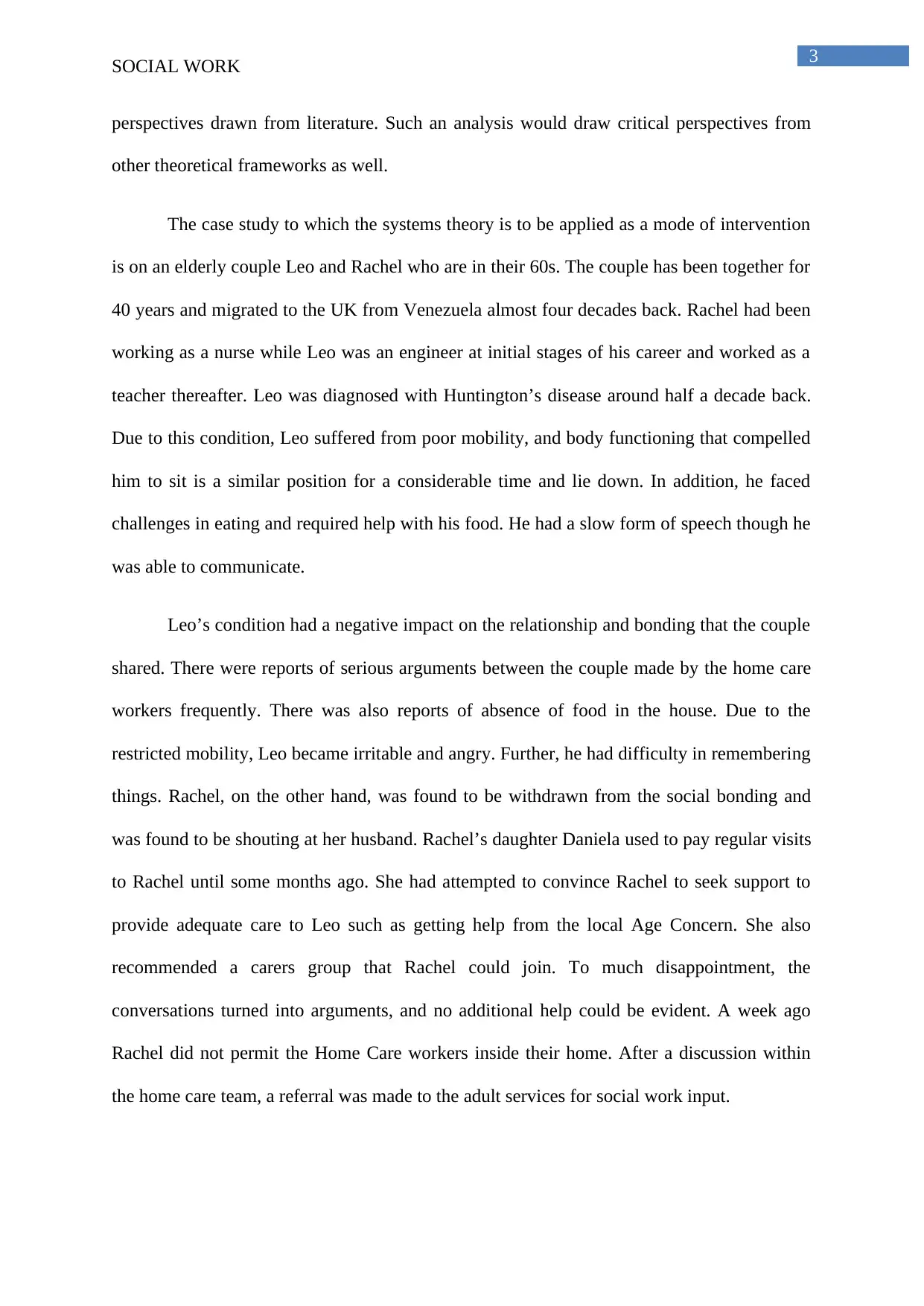
3
SOCIAL WORK
perspectives drawn from literature. Such an analysis would draw critical perspectives from
other theoretical frameworks as well.
The case study to which the systems theory is to be applied as a mode of intervention
is on an elderly couple Leo and Rachel who are in their 60s. The couple has been together for
40 years and migrated to the UK from Venezuela almost four decades back. Rachel had been
working as a nurse while Leo was an engineer at initial stages of his career and worked as a
teacher thereafter. Leo was diagnosed with Huntington’s disease around half a decade back.
Due to this condition, Leo suffered from poor mobility, and body functioning that compelled
him to sit is a similar position for a considerable time and lie down. In addition, he faced
challenges in eating and required help with his food. He had a slow form of speech though he
was able to communicate.
Leo’s condition had a negative impact on the relationship and bonding that the couple
shared. There were reports of serious arguments between the couple made by the home care
workers frequently. There was also reports of absence of food in the house. Due to the
restricted mobility, Leo became irritable and angry. Further, he had difficulty in remembering
things. Rachel, on the other hand, was found to be withdrawn from the social bonding and
was found to be shouting at her husband. Rachel’s daughter Daniela used to pay regular visits
to Rachel until some months ago. She had attempted to convince Rachel to seek support to
provide adequate care to Leo such as getting help from the local Age Concern. She also
recommended a carers group that Rachel could join. To much disappointment, the
conversations turned into arguments, and no additional help could be evident. A week ago
Rachel did not permit the Home Care workers inside their home. After a discussion within
the home care team, a referral was made to the adult services for social work input.
SOCIAL WORK
perspectives drawn from literature. Such an analysis would draw critical perspectives from
other theoretical frameworks as well.
The case study to which the systems theory is to be applied as a mode of intervention
is on an elderly couple Leo and Rachel who are in their 60s. The couple has been together for
40 years and migrated to the UK from Venezuela almost four decades back. Rachel had been
working as a nurse while Leo was an engineer at initial stages of his career and worked as a
teacher thereafter. Leo was diagnosed with Huntington’s disease around half a decade back.
Due to this condition, Leo suffered from poor mobility, and body functioning that compelled
him to sit is a similar position for a considerable time and lie down. In addition, he faced
challenges in eating and required help with his food. He had a slow form of speech though he
was able to communicate.
Leo’s condition had a negative impact on the relationship and bonding that the couple
shared. There were reports of serious arguments between the couple made by the home care
workers frequently. There was also reports of absence of food in the house. Due to the
restricted mobility, Leo became irritable and angry. Further, he had difficulty in remembering
things. Rachel, on the other hand, was found to be withdrawn from the social bonding and
was found to be shouting at her husband. Rachel’s daughter Daniela used to pay regular visits
to Rachel until some months ago. She had attempted to convince Rachel to seek support to
provide adequate care to Leo such as getting help from the local Age Concern. She also
recommended a carers group that Rachel could join. To much disappointment, the
conversations turned into arguments, and no additional help could be evident. A week ago
Rachel did not permit the Home Care workers inside their home. After a discussion within
the home care team, a referral was made to the adult services for social work input.
⊘ This is a preview!⊘
Do you want full access?
Subscribe today to unlock all pages.

Trusted by 1+ million students worldwide
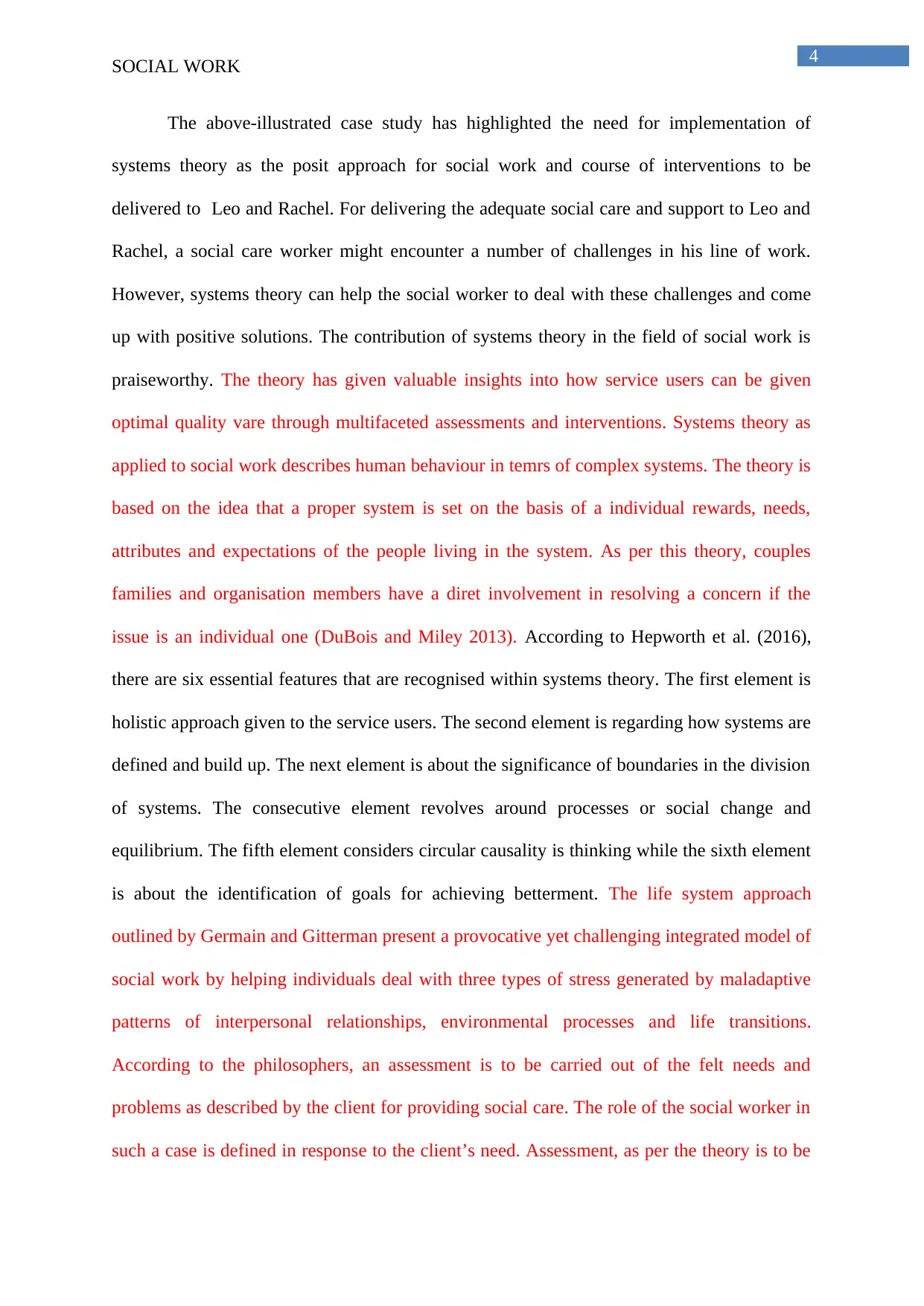
4
SOCIAL WORK
The above-illustrated case study has highlighted the need for implementation of
systems theory as the posit approach for social work and course of interventions to be
delivered to Leo and Rachel. For delivering the adequate social care and support to Leo and
Rachel, a social care worker might encounter a number of challenges in his line of work.
However, systems theory can help the social worker to deal with these challenges and come
up with positive solutions. The contribution of systems theory in the field of social work is
praiseworthy. The theory has given valuable insights into how service users can be given
optimal quality vare through multifaceted assessments and interventions. Systems theory as
applied to social work describes human behaviour in temrs of complex systems. The theory is
based on the idea that a proper system is set on the basis of a individual rewards, needs,
attributes and expectations of the people living in the system. As per this theory, couples
families and organisation members have a diret involvement in resolving a concern if the
issue is an individual one (DuBois and Miley 2013). According to Hepworth et al. (2016),
there are six essential features that are recognised within systems theory. The first element is
holistic approach given to the service users. The second element is regarding how systems are
defined and build up. The next element is about the significance of boundaries in the division
of systems. The consecutive element revolves around processes or social change and
equilibrium. The fifth element considers circular causality is thinking while the sixth element
is about the identification of goals for achieving betterment. The life system approach
outlined by Germain and Gitterman present a provocative yet challenging integrated model of
social work by helping individuals deal with three types of stress generated by maladaptive
patterns of interpersonal relationships, environmental processes and life transitions.
According to the philosophers, an assessment is to be carried out of the felt needs and
problems as described by the client for providing social care. The role of the social worker in
such a case is defined in response to the client’s need. Assessment, as per the theory is to be
SOCIAL WORK
The above-illustrated case study has highlighted the need for implementation of
systems theory as the posit approach for social work and course of interventions to be
delivered to Leo and Rachel. For delivering the adequate social care and support to Leo and
Rachel, a social care worker might encounter a number of challenges in his line of work.
However, systems theory can help the social worker to deal with these challenges and come
up with positive solutions. The contribution of systems theory in the field of social work is
praiseworthy. The theory has given valuable insights into how service users can be given
optimal quality vare through multifaceted assessments and interventions. Systems theory as
applied to social work describes human behaviour in temrs of complex systems. The theory is
based on the idea that a proper system is set on the basis of a individual rewards, needs,
attributes and expectations of the people living in the system. As per this theory, couples
families and organisation members have a diret involvement in resolving a concern if the
issue is an individual one (DuBois and Miley 2013). According to Hepworth et al. (2016),
there are six essential features that are recognised within systems theory. The first element is
holistic approach given to the service users. The second element is regarding how systems are
defined and build up. The next element is about the significance of boundaries in the division
of systems. The consecutive element revolves around processes or social change and
equilibrium. The fifth element considers circular causality is thinking while the sixth element
is about the identification of goals for achieving betterment. The life system approach
outlined by Germain and Gitterman present a provocative yet challenging integrated model of
social work by helping individuals deal with three types of stress generated by maladaptive
patterns of interpersonal relationships, environmental processes and life transitions.
According to the philosophers, an assessment is to be carried out of the felt needs and
problems as described by the client for providing social care. The role of the social worker in
such a case is defined in response to the client’s need. Assessment, as per the theory is to be
Paraphrase This Document
Need a fresh take? Get an instant paraphrase of this document with our AI Paraphraser
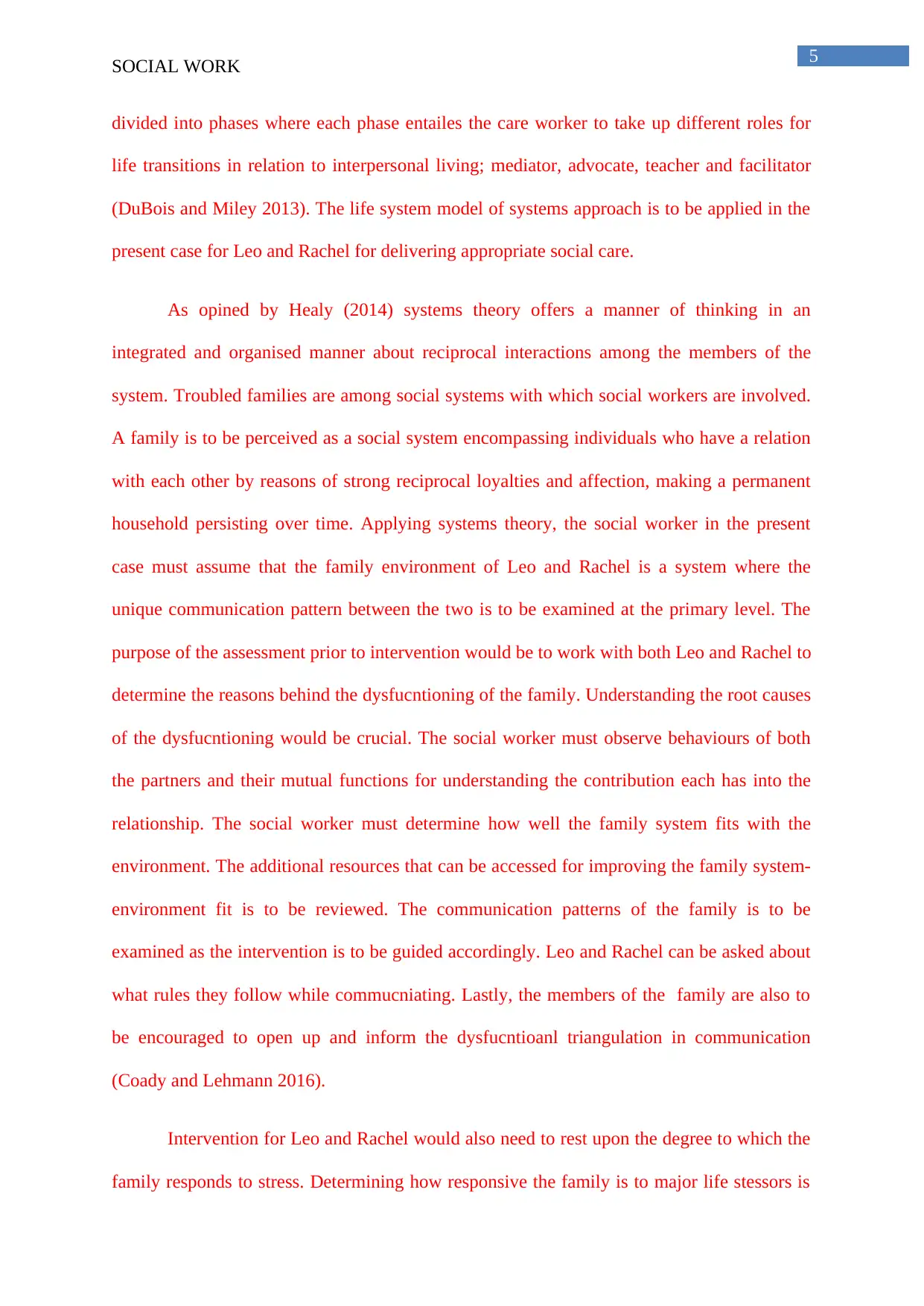
5
SOCIAL WORK
divided into phases where each phase entailes the care worker to take up different roles for
life transitions in relation to interpersonal living; mediator, advocate, teacher and facilitator
(DuBois and Miley 2013). The life system model of systems approach is to be applied in the
present case for Leo and Rachel for delivering appropriate social care.
As opined by Healy (2014) systems theory offers a manner of thinking in an
integrated and organised manner about reciprocal interactions among the members of the
system. Troubled families are among social systems with which social workers are involved.
A family is to be perceived as a social system encompassing individuals who have a relation
with each other by reasons of strong reciprocal loyalties and affection, making a permanent
household persisting over time. Applying systems theory, the social worker in the present
case must assume that the family environment of Leo and Rachel is a system where the
unique communication pattern between the two is to be examined at the primary level. The
purpose of the assessment prior to intervention would be to work with both Leo and Rachel to
determine the reasons behind the dysfucntioning of the family. Understanding the root causes
of the dysfucntioning would be crucial. The social worker must observe behaviours of both
the partners and their mutual functions for understanding the contribution each has into the
relationship. The social worker must determine how well the family system fits with the
environment. The additional resources that can be accessed for improving the family system-
environment fit is to be reviewed. The communication patterns of the family is to be
examined as the intervention is to be guided accordingly. Leo and Rachel can be asked about
what rules they follow while commucniating. Lastly, the members of the family are also to
be encouraged to open up and inform the dysfucntioanl triangulation in communication
(Coady and Lehmann 2016).
Intervention for Leo and Rachel would also need to rest upon the degree to which the
family responds to stress. Determining how responsive the family is to major life stessors is
SOCIAL WORK
divided into phases where each phase entailes the care worker to take up different roles for
life transitions in relation to interpersonal living; mediator, advocate, teacher and facilitator
(DuBois and Miley 2013). The life system model of systems approach is to be applied in the
present case for Leo and Rachel for delivering appropriate social care.
As opined by Healy (2014) systems theory offers a manner of thinking in an
integrated and organised manner about reciprocal interactions among the members of the
system. Troubled families are among social systems with which social workers are involved.
A family is to be perceived as a social system encompassing individuals who have a relation
with each other by reasons of strong reciprocal loyalties and affection, making a permanent
household persisting over time. Applying systems theory, the social worker in the present
case must assume that the family environment of Leo and Rachel is a system where the
unique communication pattern between the two is to be examined at the primary level. The
purpose of the assessment prior to intervention would be to work with both Leo and Rachel to
determine the reasons behind the dysfucntioning of the family. Understanding the root causes
of the dysfucntioning would be crucial. The social worker must observe behaviours of both
the partners and their mutual functions for understanding the contribution each has into the
relationship. The social worker must determine how well the family system fits with the
environment. The additional resources that can be accessed for improving the family system-
environment fit is to be reviewed. The communication patterns of the family is to be
examined as the intervention is to be guided accordingly. Leo and Rachel can be asked about
what rules they follow while commucniating. Lastly, the members of the family are also to
be encouraged to open up and inform the dysfucntioanl triangulation in communication
(Coady and Lehmann 2016).
Intervention for Leo and Rachel would also need to rest upon the degree to which the
family responds to stress. Determining how responsive the family is to major life stessors is
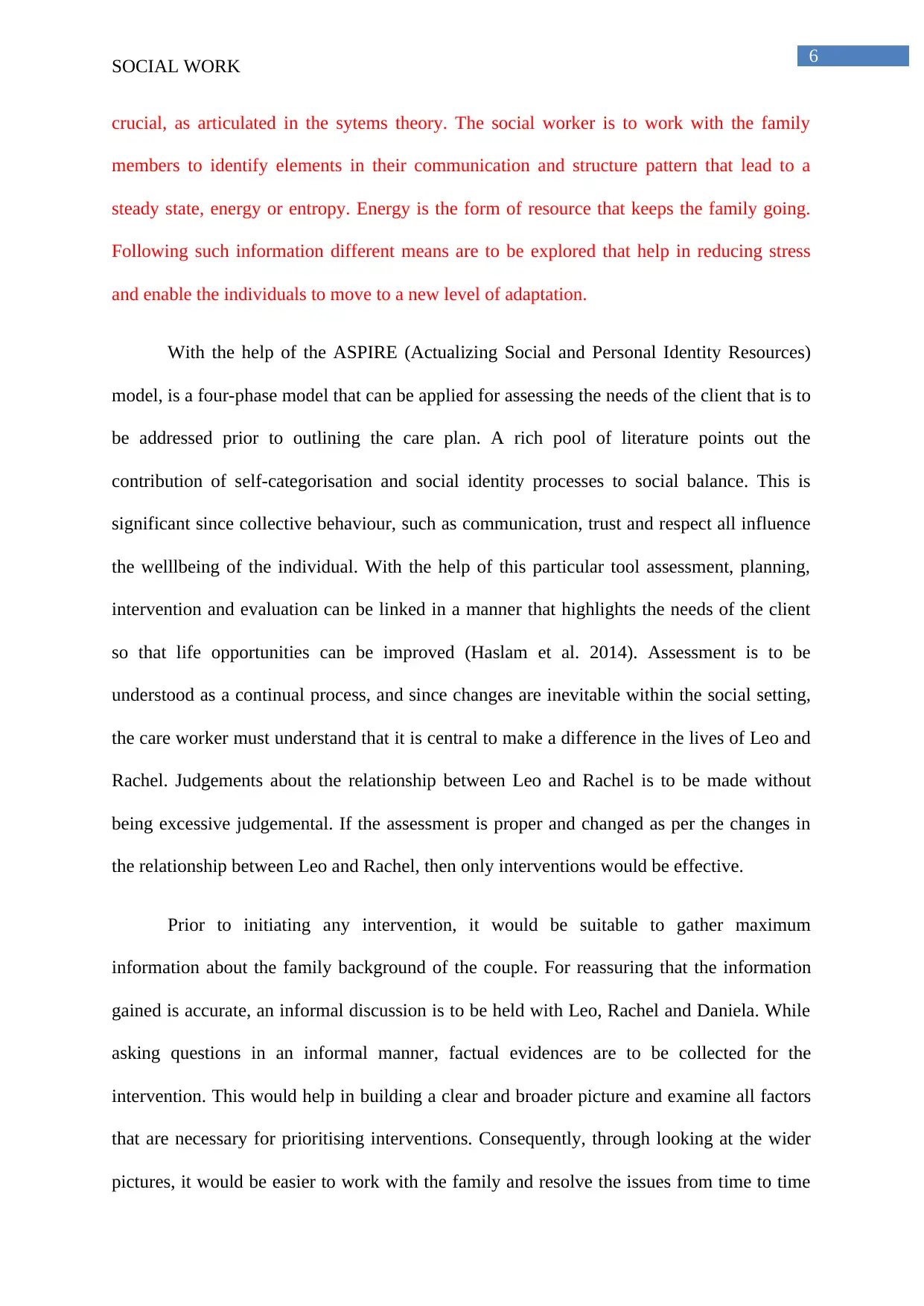
6
SOCIAL WORK
crucial, as articulated in the sytems theory. The social worker is to work with the family
members to identify elements in their communication and structure pattern that lead to a
steady state, energy or entropy. Energy is the form of resource that keeps the family going.
Following such information different means are to be explored that help in reducing stress
and enable the individuals to move to a new level of adaptation.
With the help of the ASPIRE (Actualizing Social and Personal Identity Resources)
model, is a four-phase model that can be applied for assessing the needs of the client that is to
be addressed prior to outlining the care plan. A rich pool of literature points out the
contribution of self-categorisation and social identity processes to social balance. This is
significant since collective behaviour, such as communication, trust and respect all influence
the welllbeing of the individual. With the help of this particular tool assessment, planning,
intervention and evaluation can be linked in a manner that highlights the needs of the client
so that life opportunities can be improved (Haslam et al. 2014). Assessment is to be
understood as a continual process, and since changes are inevitable within the social setting,
the care worker must understand that it is central to make a difference in the lives of Leo and
Rachel. Judgements about the relationship between Leo and Rachel is to be made without
being excessive judgemental. If the assessment is proper and changed as per the changes in
the relationship between Leo and Rachel, then only interventions would be effective.
Prior to initiating any intervention, it would be suitable to gather maximum
information about the family background of the couple. For reassuring that the information
gained is accurate, an informal discussion is to be held with Leo, Rachel and Daniela. While
asking questions in an informal manner, factual evidences are to be collected for the
intervention. This would help in building a clear and broader picture and examine all factors
that are necessary for prioritising interventions. Consequently, through looking at the wider
pictures, it would be easier to work with the family and resolve the issues from time to time
SOCIAL WORK
crucial, as articulated in the sytems theory. The social worker is to work with the family
members to identify elements in their communication and structure pattern that lead to a
steady state, energy or entropy. Energy is the form of resource that keeps the family going.
Following such information different means are to be explored that help in reducing stress
and enable the individuals to move to a new level of adaptation.
With the help of the ASPIRE (Actualizing Social and Personal Identity Resources)
model, is a four-phase model that can be applied for assessing the needs of the client that is to
be addressed prior to outlining the care plan. A rich pool of literature points out the
contribution of self-categorisation and social identity processes to social balance. This is
significant since collective behaviour, such as communication, trust and respect all influence
the welllbeing of the individual. With the help of this particular tool assessment, planning,
intervention and evaluation can be linked in a manner that highlights the needs of the client
so that life opportunities can be improved (Haslam et al. 2014). Assessment is to be
understood as a continual process, and since changes are inevitable within the social setting,
the care worker must understand that it is central to make a difference in the lives of Leo and
Rachel. Judgements about the relationship between Leo and Rachel is to be made without
being excessive judgemental. If the assessment is proper and changed as per the changes in
the relationship between Leo and Rachel, then only interventions would be effective.
Prior to initiating any intervention, it would be suitable to gather maximum
information about the family background of the couple. For reassuring that the information
gained is accurate, an informal discussion is to be held with Leo, Rachel and Daniela. While
asking questions in an informal manner, factual evidences are to be collected for the
intervention. This would help in building a clear and broader picture and examine all factors
that are necessary for prioritising interventions. Consequently, through looking at the wider
pictures, it would be easier to work with the family and resolve the issues from time to time
⊘ This is a preview!⊘
Do you want full access?
Subscribe today to unlock all pages.

Trusted by 1+ million students worldwide
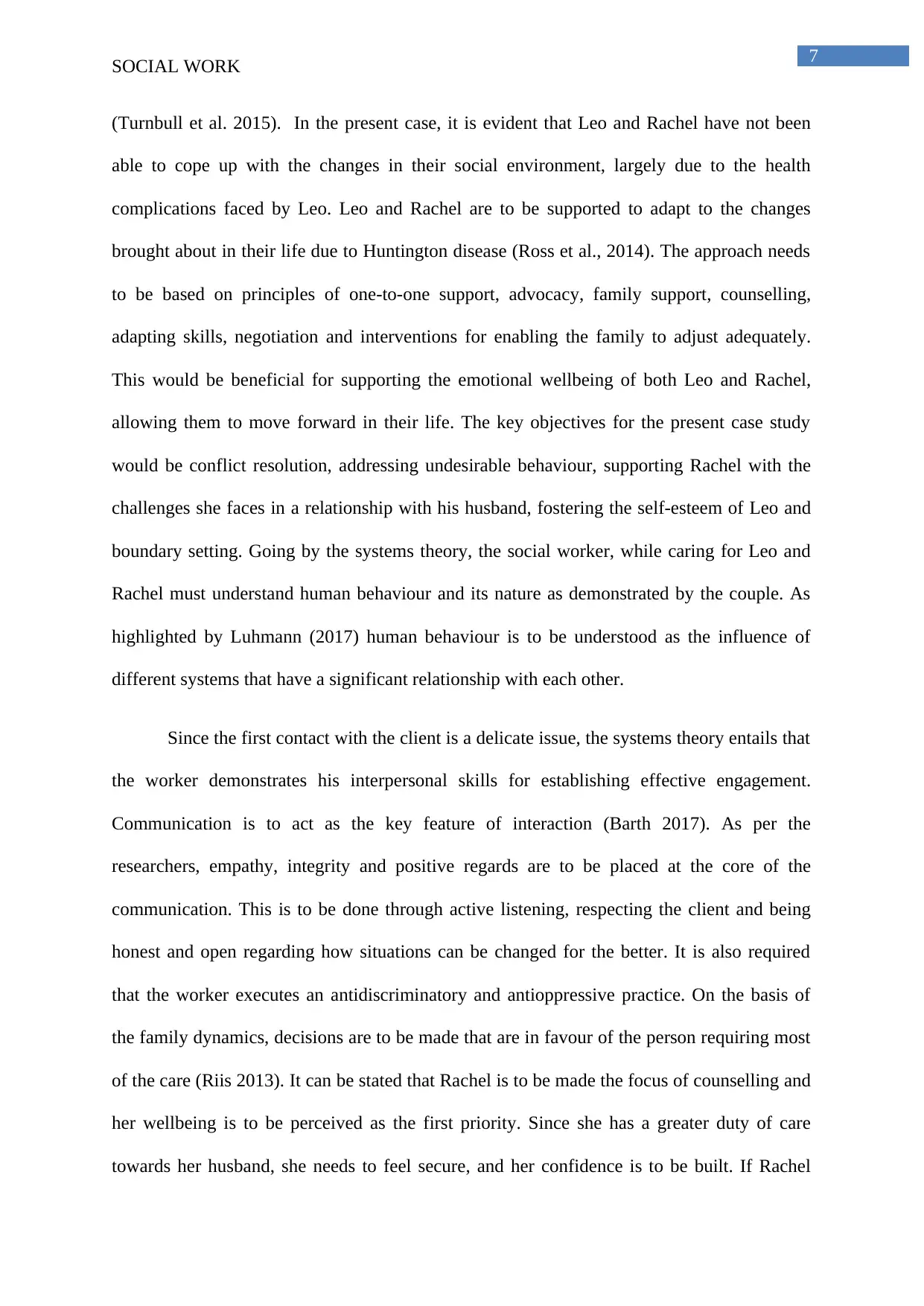
7
SOCIAL WORK
(Turnbull et al. 2015). In the present case, it is evident that Leo and Rachel have not been
able to cope up with the changes in their social environment, largely due to the health
complications faced by Leo. Leo and Rachel are to be supported to adapt to the changes
brought about in their life due to Huntington disease (Ross et al., 2014). The approach needs
to be based on principles of one-to-one support, advocacy, family support, counselling,
adapting skills, negotiation and interventions for enabling the family to adjust adequately.
This would be beneficial for supporting the emotional wellbeing of both Leo and Rachel,
allowing them to move forward in their life. The key objectives for the present case study
would be conflict resolution, addressing undesirable behaviour, supporting Rachel with the
challenges she faces in a relationship with his husband, fostering the self-esteem of Leo and
boundary setting. Going by the systems theory, the social worker, while caring for Leo and
Rachel must understand human behaviour and its nature as demonstrated by the couple. As
highlighted by Luhmann (2017) human behaviour is to be understood as the influence of
different systems that have a significant relationship with each other.
Since the first contact with the client is a delicate issue, the systems theory entails that
the worker demonstrates his interpersonal skills for establishing effective engagement.
Communication is to act as the key feature of interaction (Barth 2017). As per the
researchers, empathy, integrity and positive regards are to be placed at the core of the
communication. This is to be done through active listening, respecting the client and being
honest and open regarding how situations can be changed for the better. It is also required
that the worker executes an antidiscriminatory and antioppressive practice. On the basis of
the family dynamics, decisions are to be made that are in favour of the person requiring most
of the care (Riis 2013). It can be stated that Rachel is to be made the focus of counselling and
her wellbeing is to be perceived as the first priority. Since she has a greater duty of care
towards her husband, she needs to feel secure, and her confidence is to be built. If Rachel
SOCIAL WORK
(Turnbull et al. 2015). In the present case, it is evident that Leo and Rachel have not been
able to cope up with the changes in their social environment, largely due to the health
complications faced by Leo. Leo and Rachel are to be supported to adapt to the changes
brought about in their life due to Huntington disease (Ross et al., 2014). The approach needs
to be based on principles of one-to-one support, advocacy, family support, counselling,
adapting skills, negotiation and interventions for enabling the family to adjust adequately.
This would be beneficial for supporting the emotional wellbeing of both Leo and Rachel,
allowing them to move forward in their life. The key objectives for the present case study
would be conflict resolution, addressing undesirable behaviour, supporting Rachel with the
challenges she faces in a relationship with his husband, fostering the self-esteem of Leo and
boundary setting. Going by the systems theory, the social worker, while caring for Leo and
Rachel must understand human behaviour and its nature as demonstrated by the couple. As
highlighted by Luhmann (2017) human behaviour is to be understood as the influence of
different systems that have a significant relationship with each other.
Since the first contact with the client is a delicate issue, the systems theory entails that
the worker demonstrates his interpersonal skills for establishing effective engagement.
Communication is to act as the key feature of interaction (Barth 2017). As per the
researchers, empathy, integrity and positive regards are to be placed at the core of the
communication. This is to be done through active listening, respecting the client and being
honest and open regarding how situations can be changed for the better. It is also required
that the worker executes an antidiscriminatory and antioppressive practice. On the basis of
the family dynamics, decisions are to be made that are in favour of the person requiring most
of the care (Riis 2013). It can be stated that Rachel is to be made the focus of counselling and
her wellbeing is to be perceived as the first priority. Since she has a greater duty of care
towards her husband, she needs to feel secure, and her confidence is to be built. If Rachel
Paraphrase This Document
Need a fresh take? Get an instant paraphrase of this document with our AI Paraphraser
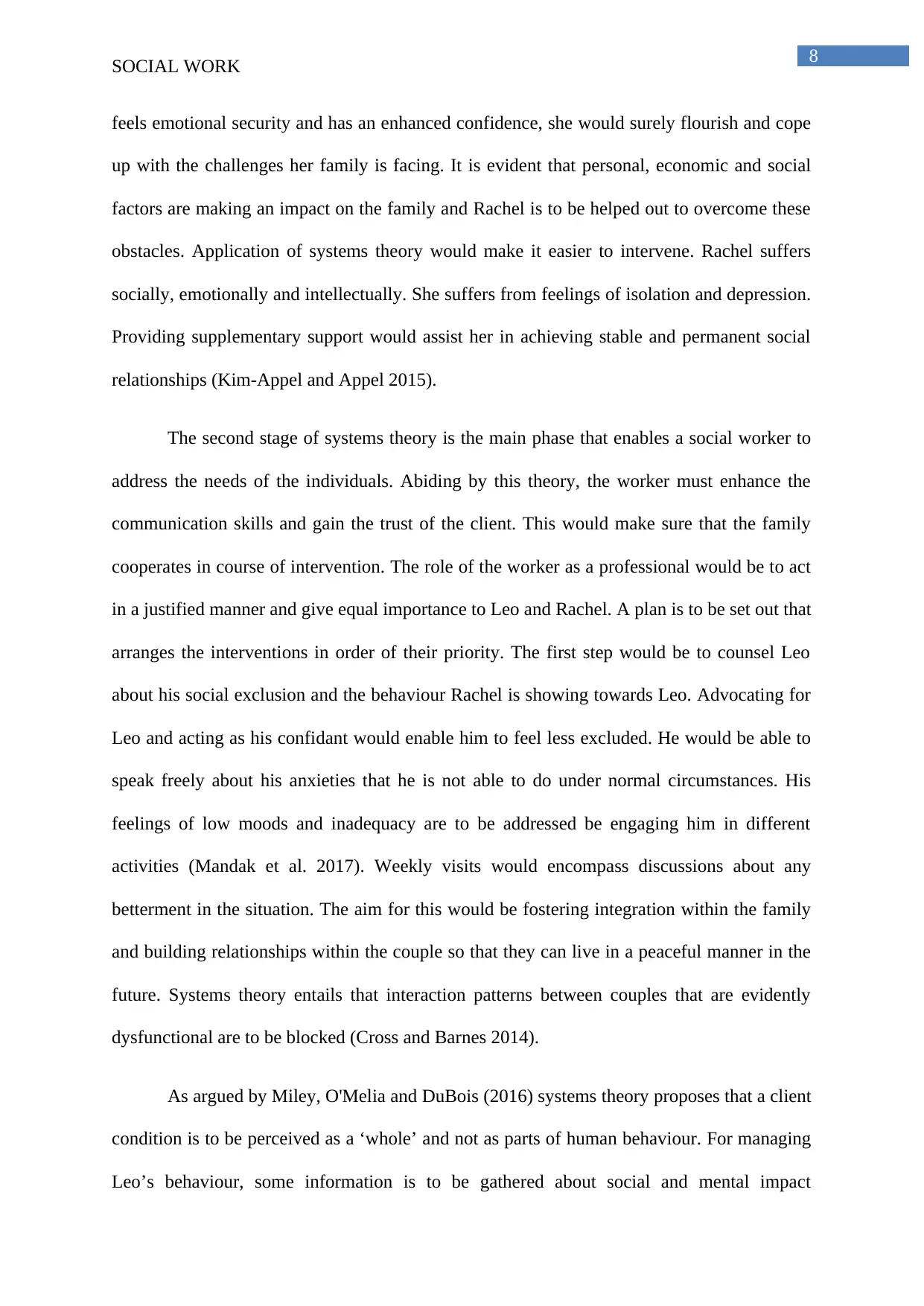
8
SOCIAL WORK
feels emotional security and has an enhanced confidence, she would surely flourish and cope
up with the challenges her family is facing. It is evident that personal, economic and social
factors are making an impact on the family and Rachel is to be helped out to overcome these
obstacles. Application of systems theory would make it easier to intervene. Rachel suffers
socially, emotionally and intellectually. She suffers from feelings of isolation and depression.
Providing supplementary support would assist her in achieving stable and permanent social
relationships (Kim-Appel and Appel 2015).
The second stage of systems theory is the main phase that enables a social worker to
address the needs of the individuals. Abiding by this theory, the worker must enhance the
communication skills and gain the trust of the client. This would make sure that the family
cooperates in course of intervention. The role of the worker as a professional would be to act
in a justified manner and give equal importance to Leo and Rachel. A plan is to be set out that
arranges the interventions in order of their priority. The first step would be to counsel Leo
about his social exclusion and the behaviour Rachel is showing towards Leo. Advocating for
Leo and acting as his confidant would enable him to feel less excluded. He would be able to
speak freely about his anxieties that he is not able to do under normal circumstances. His
feelings of low moods and inadequacy are to be addressed be engaging him in different
activities (Mandak et al. 2017). Weekly visits would encompass discussions about any
betterment in the situation. The aim for this would be fostering integration within the family
and building relationships within the couple so that they can live in a peaceful manner in the
future. Systems theory entails that interaction patterns between couples that are evidently
dysfunctional are to be blocked (Cross and Barnes 2014).
As argued by Miley, O'Melia and DuBois (2016) systems theory proposes that a client
condition is to be perceived as a ‘whole’ and not as parts of human behaviour. For managing
Leo’s behaviour, some information is to be gathered about social and mental impact
SOCIAL WORK
feels emotional security and has an enhanced confidence, she would surely flourish and cope
up with the challenges her family is facing. It is evident that personal, economic and social
factors are making an impact on the family and Rachel is to be helped out to overcome these
obstacles. Application of systems theory would make it easier to intervene. Rachel suffers
socially, emotionally and intellectually. She suffers from feelings of isolation and depression.
Providing supplementary support would assist her in achieving stable and permanent social
relationships (Kim-Appel and Appel 2015).
The second stage of systems theory is the main phase that enables a social worker to
address the needs of the individuals. Abiding by this theory, the worker must enhance the
communication skills and gain the trust of the client. This would make sure that the family
cooperates in course of intervention. The role of the worker as a professional would be to act
in a justified manner and give equal importance to Leo and Rachel. A plan is to be set out that
arranges the interventions in order of their priority. The first step would be to counsel Leo
about his social exclusion and the behaviour Rachel is showing towards Leo. Advocating for
Leo and acting as his confidant would enable him to feel less excluded. He would be able to
speak freely about his anxieties that he is not able to do under normal circumstances. His
feelings of low moods and inadequacy are to be addressed be engaging him in different
activities (Mandak et al. 2017). Weekly visits would encompass discussions about any
betterment in the situation. The aim for this would be fostering integration within the family
and building relationships within the couple so that they can live in a peaceful manner in the
future. Systems theory entails that interaction patterns between couples that are evidently
dysfunctional are to be blocked (Cross and Barnes 2014).
As argued by Miley, O'Melia and DuBois (2016) systems theory proposes that a client
condition is to be perceived as a ‘whole’ and not as parts of human behaviour. For managing
Leo’s behaviour, some information is to be gathered about social and mental impact
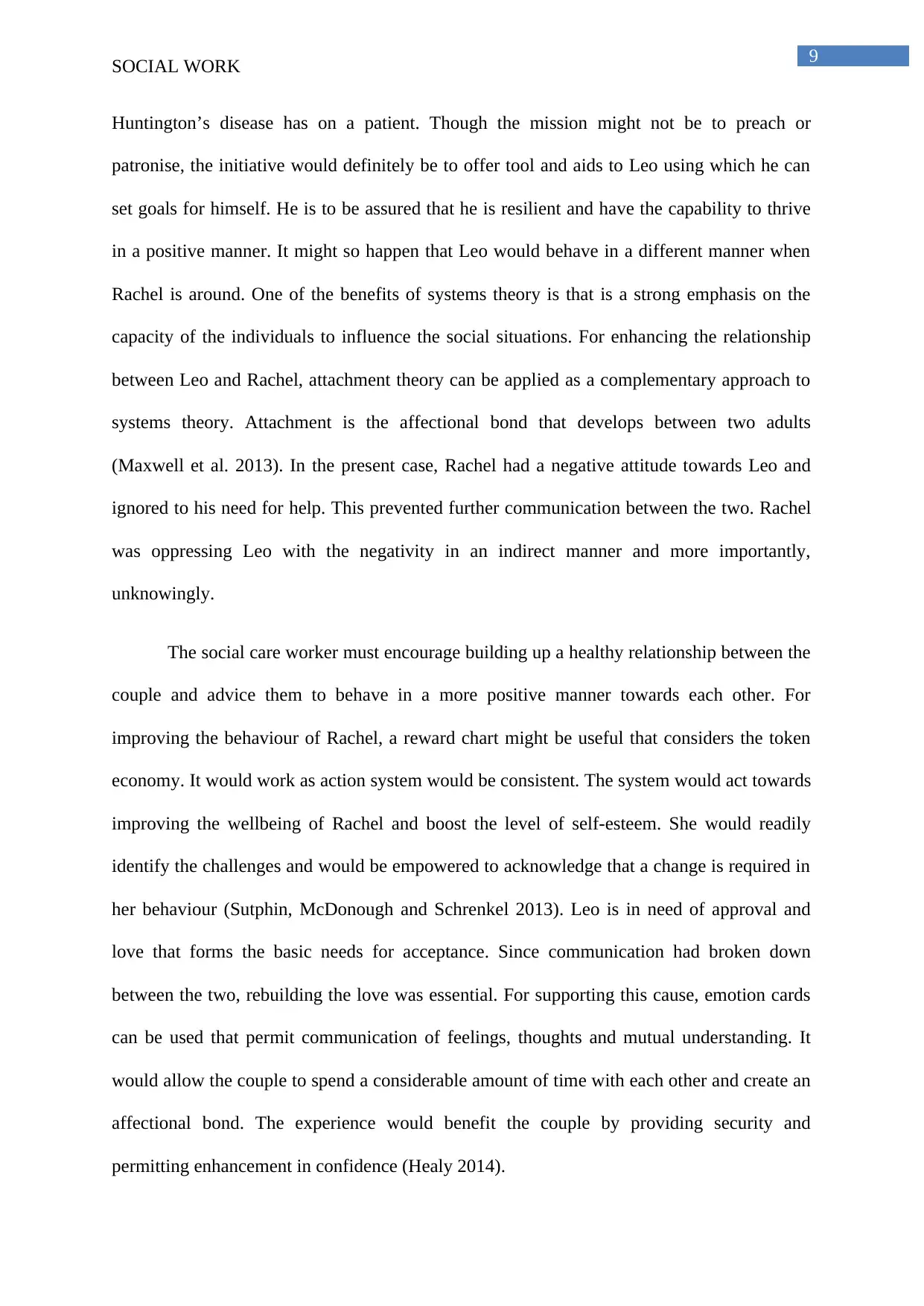
9
SOCIAL WORK
Huntington’s disease has on a patient. Though the mission might not be to preach or
patronise, the initiative would definitely be to offer tool and aids to Leo using which he can
set goals for himself. He is to be assured that he is resilient and have the capability to thrive
in a positive manner. It might so happen that Leo would behave in a different manner when
Rachel is around. One of the benefits of systems theory is that is a strong emphasis on the
capacity of the individuals to influence the social situations. For enhancing the relationship
between Leo and Rachel, attachment theory can be applied as a complementary approach to
systems theory. Attachment is the affectional bond that develops between two adults
(Maxwell et al. 2013). In the present case, Rachel had a negative attitude towards Leo and
ignored to his need for help. This prevented further communication between the two. Rachel
was oppressing Leo with the negativity in an indirect manner and more importantly,
unknowingly.
The social care worker must encourage building up a healthy relationship between the
couple and advice them to behave in a more positive manner towards each other. For
improving the behaviour of Rachel, a reward chart might be useful that considers the token
economy. It would work as action system would be consistent. The system would act towards
improving the wellbeing of Rachel and boost the level of self-esteem. She would readily
identify the challenges and would be empowered to acknowledge that a change is required in
her behaviour (Sutphin, McDonough and Schrenkel 2013). Leo is in need of approval and
love that forms the basic needs for acceptance. Since communication had broken down
between the two, rebuilding the love was essential. For supporting this cause, emotion cards
can be used that permit communication of feelings, thoughts and mutual understanding. It
would allow the couple to spend a considerable amount of time with each other and create an
affectional bond. The experience would benefit the couple by providing security and
permitting enhancement in confidence (Healy 2014).
SOCIAL WORK
Huntington’s disease has on a patient. Though the mission might not be to preach or
patronise, the initiative would definitely be to offer tool and aids to Leo using which he can
set goals for himself. He is to be assured that he is resilient and have the capability to thrive
in a positive manner. It might so happen that Leo would behave in a different manner when
Rachel is around. One of the benefits of systems theory is that is a strong emphasis on the
capacity of the individuals to influence the social situations. For enhancing the relationship
between Leo and Rachel, attachment theory can be applied as a complementary approach to
systems theory. Attachment is the affectional bond that develops between two adults
(Maxwell et al. 2013). In the present case, Rachel had a negative attitude towards Leo and
ignored to his need for help. This prevented further communication between the two. Rachel
was oppressing Leo with the negativity in an indirect manner and more importantly,
unknowingly.
The social care worker must encourage building up a healthy relationship between the
couple and advice them to behave in a more positive manner towards each other. For
improving the behaviour of Rachel, a reward chart might be useful that considers the token
economy. It would work as action system would be consistent. The system would act towards
improving the wellbeing of Rachel and boost the level of self-esteem. She would readily
identify the challenges and would be empowered to acknowledge that a change is required in
her behaviour (Sutphin, McDonough and Schrenkel 2013). Leo is in need of approval and
love that forms the basic needs for acceptance. Since communication had broken down
between the two, rebuilding the love was essential. For supporting this cause, emotion cards
can be used that permit communication of feelings, thoughts and mutual understanding. It
would allow the couple to spend a considerable amount of time with each other and create an
affectional bond. The experience would benefit the couple by providing security and
permitting enhancement in confidence (Healy 2014).
⊘ This is a preview!⊘
Do you want full access?
Subscribe today to unlock all pages.

Trusted by 1+ million students worldwide
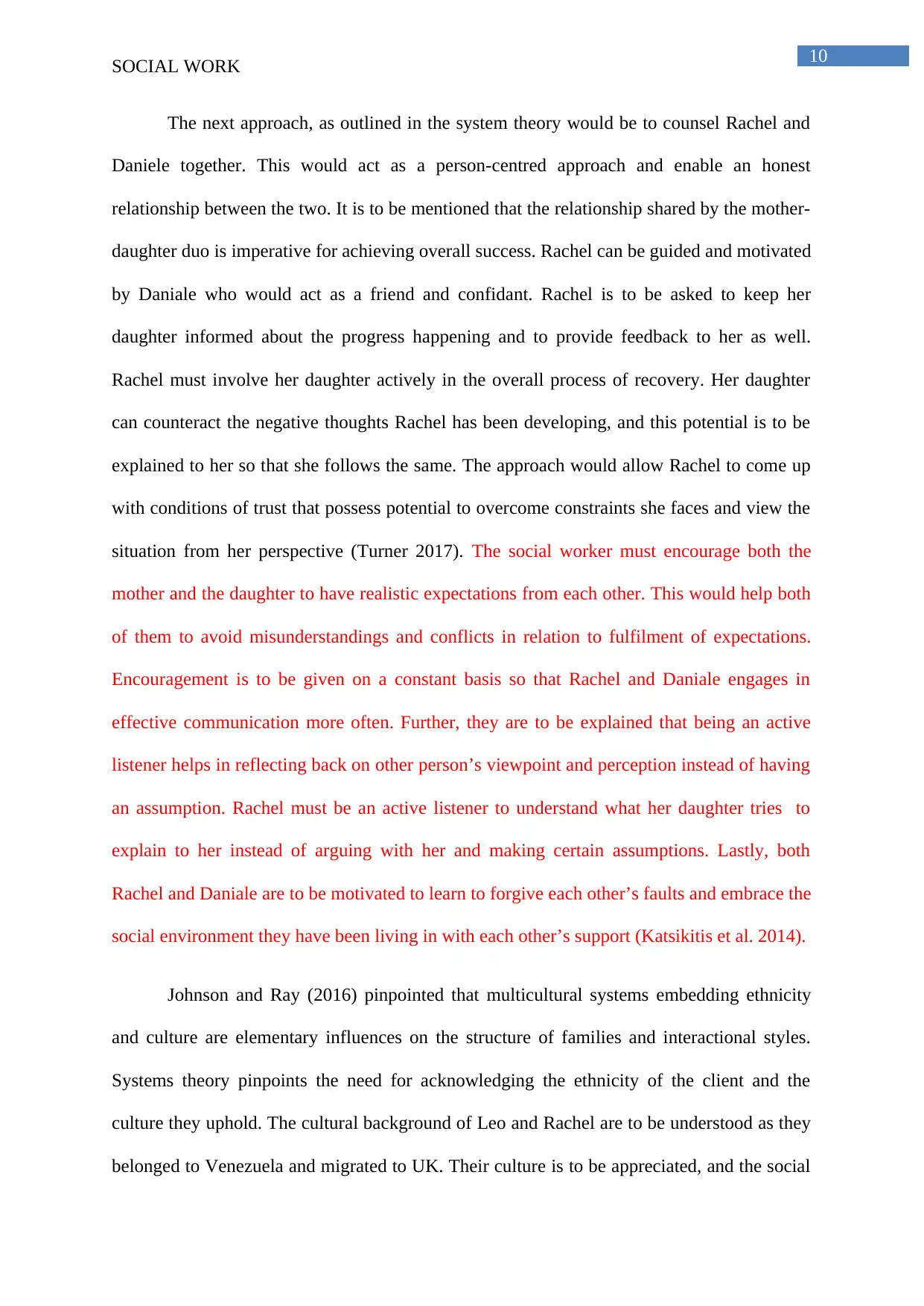
10
SOCIAL WORK
The next approach, as outlined in the system theory would be to counsel Rachel and
Daniele together. This would act as a person-centred approach and enable an honest
relationship between the two. It is to be mentioned that the relationship shared by the mother-
daughter duo is imperative for achieving overall success. Rachel can be guided and motivated
by Daniale who would act as a friend and confidant. Rachel is to be asked to keep her
daughter informed about the progress happening and to provide feedback to her as well.
Rachel must involve her daughter actively in the overall process of recovery. Her daughter
can counteract the negative thoughts Rachel has been developing, and this potential is to be
explained to her so that she follows the same. The approach would allow Rachel to come up
with conditions of trust that possess potential to overcome constraints she faces and view the
situation from her perspective (Turner 2017). The social worker must encourage both the
mother and the daughter to have realistic expectations from each other. This would help both
of them to avoid misunderstandings and conflicts in relation to fulfilment of expectations.
Encouragement is to be given on a constant basis so that Rachel and Daniale engages in
effective communication more often. Further, they are to be explained that being an active
listener helps in reflecting back on other person’s viewpoint and perception instead of having
an assumption. Rachel must be an active listener to understand what her daughter tries to
explain to her instead of arguing with her and making certain assumptions. Lastly, both
Rachel and Daniale are to be motivated to learn to forgive each other’s faults and embrace the
social environment they have been living in with each other’s support (Katsikitis et al. 2014).
Johnson and Ray (2016) pinpointed that multicultural systems embedding ethnicity
and culture are elementary influences on the structure of families and interactional styles.
Systems theory pinpoints the need for acknowledging the ethnicity of the client and the
culture they uphold. The cultural background of Leo and Rachel are to be understood as they
belonged to Venezuela and migrated to UK. Their culture is to be appreciated, and the social
SOCIAL WORK
The next approach, as outlined in the system theory would be to counsel Rachel and
Daniele together. This would act as a person-centred approach and enable an honest
relationship between the two. It is to be mentioned that the relationship shared by the mother-
daughter duo is imperative for achieving overall success. Rachel can be guided and motivated
by Daniale who would act as a friend and confidant. Rachel is to be asked to keep her
daughter informed about the progress happening and to provide feedback to her as well.
Rachel must involve her daughter actively in the overall process of recovery. Her daughter
can counteract the negative thoughts Rachel has been developing, and this potential is to be
explained to her so that she follows the same. The approach would allow Rachel to come up
with conditions of trust that possess potential to overcome constraints she faces and view the
situation from her perspective (Turner 2017). The social worker must encourage both the
mother and the daughter to have realistic expectations from each other. This would help both
of them to avoid misunderstandings and conflicts in relation to fulfilment of expectations.
Encouragement is to be given on a constant basis so that Rachel and Daniale engages in
effective communication more often. Further, they are to be explained that being an active
listener helps in reflecting back on other person’s viewpoint and perception instead of having
an assumption. Rachel must be an active listener to understand what her daughter tries to
explain to her instead of arguing with her and making certain assumptions. Lastly, both
Rachel and Daniale are to be motivated to learn to forgive each other’s faults and embrace the
social environment they have been living in with each other’s support (Katsikitis et al. 2014).
Johnson and Ray (2016) pinpointed that multicultural systems embedding ethnicity
and culture are elementary influences on the structure of families and interactional styles.
Systems theory pinpoints the need for acknowledging the ethnicity of the client and the
culture they uphold. The cultural background of Leo and Rachel are to be understood as they
belonged to Venezuela and migrated to UK. Their culture is to be appreciated, and the social
Paraphrase This Document
Need a fresh take? Get an instant paraphrase of this document with our AI Paraphraser
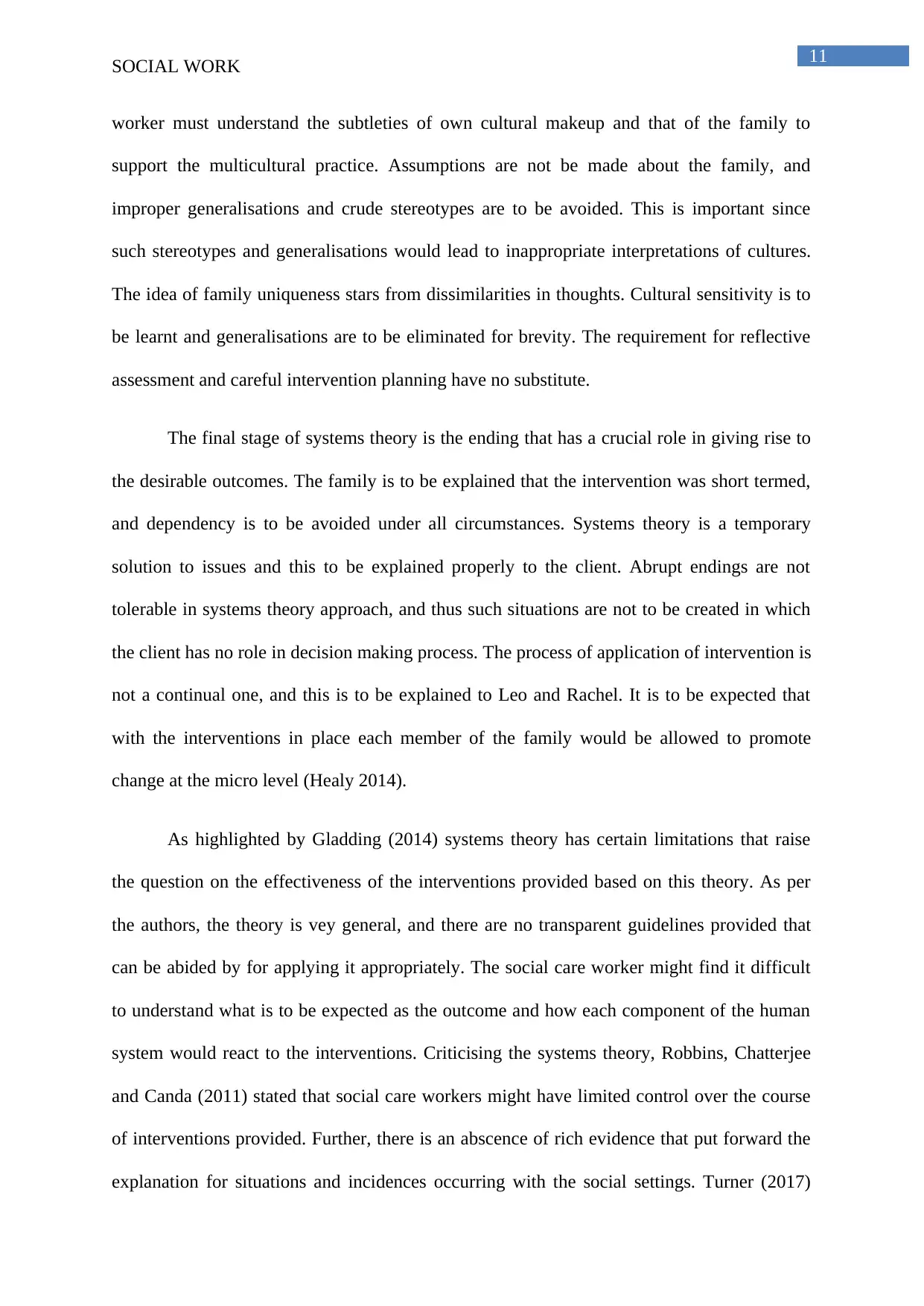
11
SOCIAL WORK
worker must understand the subtleties of own cultural makeup and that of the family to
support the multicultural practice. Assumptions are not be made about the family, and
improper generalisations and crude stereotypes are to be avoided. This is important since
such stereotypes and generalisations would lead to inappropriate interpretations of cultures.
The idea of family uniqueness stars from dissimilarities in thoughts. Cultural sensitivity is to
be learnt and generalisations are to be eliminated for brevity. The requirement for reflective
assessment and careful intervention planning have no substitute.
The final stage of systems theory is the ending that has a crucial role in giving rise to
the desirable outcomes. The family is to be explained that the intervention was short termed,
and dependency is to be avoided under all circumstances. Systems theory is a temporary
solution to issues and this to be explained properly to the client. Abrupt endings are not
tolerable in systems theory approach, and thus such situations are not to be created in which
the client has no role in decision making process. The process of application of intervention is
not a continual one, and this is to be explained to Leo and Rachel. It is to be expected that
with the interventions in place each member of the family would be allowed to promote
change at the micro level (Healy 2014).
As highlighted by Gladding (2014) systems theory has certain limitations that raise
the question on the effectiveness of the interventions provided based on this theory. As per
the authors, the theory is vey general, and there are no transparent guidelines provided that
can be abided by for applying it appropriately. The social care worker might find it difficult
to understand what is to be expected as the outcome and how each component of the human
system would react to the interventions. Criticising the systems theory, Robbins, Chatterjee
and Canda (2011) stated that social care workers might have limited control over the course
of interventions provided. Further, there is an abscence of rich evidence that put forward the
explanation for situations and incidences occurring with the social settings. Turner (2017)
SOCIAL WORK
worker must understand the subtleties of own cultural makeup and that of the family to
support the multicultural practice. Assumptions are not be made about the family, and
improper generalisations and crude stereotypes are to be avoided. This is important since
such stereotypes and generalisations would lead to inappropriate interpretations of cultures.
The idea of family uniqueness stars from dissimilarities in thoughts. Cultural sensitivity is to
be learnt and generalisations are to be eliminated for brevity. The requirement for reflective
assessment and careful intervention planning have no substitute.
The final stage of systems theory is the ending that has a crucial role in giving rise to
the desirable outcomes. The family is to be explained that the intervention was short termed,
and dependency is to be avoided under all circumstances. Systems theory is a temporary
solution to issues and this to be explained properly to the client. Abrupt endings are not
tolerable in systems theory approach, and thus such situations are not to be created in which
the client has no role in decision making process. The process of application of intervention is
not a continual one, and this is to be explained to Leo and Rachel. It is to be expected that
with the interventions in place each member of the family would be allowed to promote
change at the micro level (Healy 2014).
As highlighted by Gladding (2014) systems theory has certain limitations that raise
the question on the effectiveness of the interventions provided based on this theory. As per
the authors, the theory is vey general, and there are no transparent guidelines provided that
can be abided by for applying it appropriately. The social care worker might find it difficult
to understand what is to be expected as the outcome and how each component of the human
system would react to the interventions. Criticising the systems theory, Robbins, Chatterjee
and Canda (2011) stated that social care workers might have limited control over the course
of interventions provided. Further, there is an abscence of rich evidence that put forward the
explanation for situations and incidences occurring with the social settings. Turner (2017)
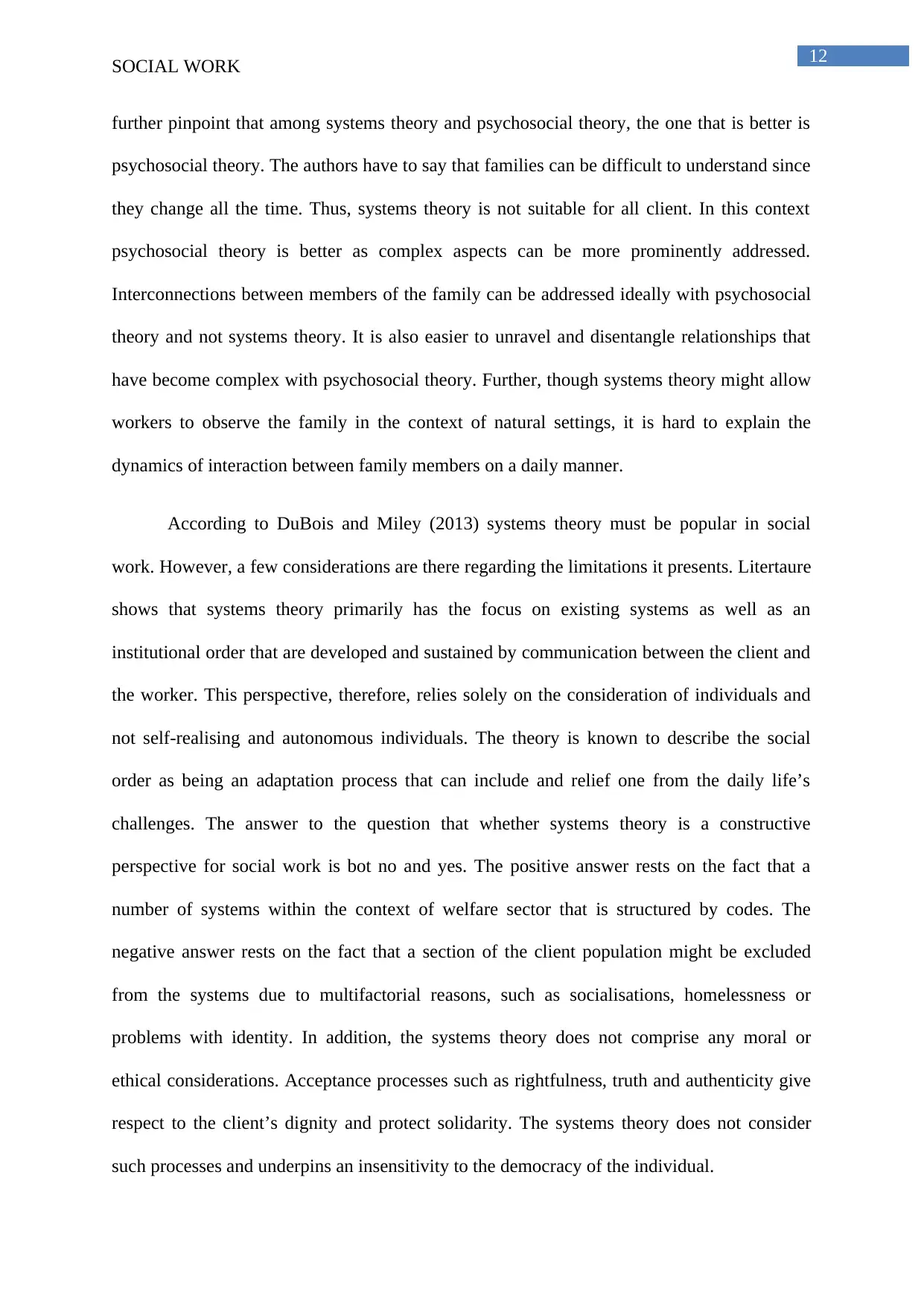
12
SOCIAL WORK
further pinpoint that among systems theory and psychosocial theory, the one that is better is
psychosocial theory. The authors have to say that families can be difficult to understand since
they change all the time. Thus, systems theory is not suitable for all client. In this context
psychosocial theory is better as complex aspects can be more prominently addressed.
Interconnections between members of the family can be addressed ideally with psychosocial
theory and not systems theory. It is also easier to unravel and disentangle relationships that
have become complex with psychosocial theory. Further, though systems theory might allow
workers to observe the family in the context of natural settings, it is hard to explain the
dynamics of interaction between family members on a daily manner.
According to DuBois and Miley (2013) systems theory must be popular in social
work. However, a few considerations are there regarding the limitations it presents. Litertaure
shows that systems theory primarily has the focus on existing systems as well as an
institutional order that are developed and sustained by communication between the client and
the worker. This perspective, therefore, relies solely on the consideration of individuals and
not self-realising and autonomous individuals. The theory is known to describe the social
order as being an adaptation process that can include and relief one from the daily life’s
challenges. The answer to the question that whether systems theory is a constructive
perspective for social work is bot no and yes. The positive answer rests on the fact that a
number of systems within the context of welfare sector that is structured by codes. The
negative answer rests on the fact that a section of the client population might be excluded
from the systems due to multifactorial reasons, such as socialisations, homelessness or
problems with identity. In addition, the systems theory does not comprise any moral or
ethical considerations. Acceptance processes such as rightfulness, truth and authenticity give
respect to the client’s dignity and protect solidarity. The systems theory does not consider
such processes and underpins an insensitivity to the democracy of the individual.
SOCIAL WORK
further pinpoint that among systems theory and psychosocial theory, the one that is better is
psychosocial theory. The authors have to say that families can be difficult to understand since
they change all the time. Thus, systems theory is not suitable for all client. In this context
psychosocial theory is better as complex aspects can be more prominently addressed.
Interconnections between members of the family can be addressed ideally with psychosocial
theory and not systems theory. It is also easier to unravel and disentangle relationships that
have become complex with psychosocial theory. Further, though systems theory might allow
workers to observe the family in the context of natural settings, it is hard to explain the
dynamics of interaction between family members on a daily manner.
According to DuBois and Miley (2013) systems theory must be popular in social
work. However, a few considerations are there regarding the limitations it presents. Litertaure
shows that systems theory primarily has the focus on existing systems as well as an
institutional order that are developed and sustained by communication between the client and
the worker. This perspective, therefore, relies solely on the consideration of individuals and
not self-realising and autonomous individuals. The theory is known to describe the social
order as being an adaptation process that can include and relief one from the daily life’s
challenges. The answer to the question that whether systems theory is a constructive
perspective for social work is bot no and yes. The positive answer rests on the fact that a
number of systems within the context of welfare sector that is structured by codes. The
negative answer rests on the fact that a section of the client population might be excluded
from the systems due to multifactorial reasons, such as socialisations, homelessness or
problems with identity. In addition, the systems theory does not comprise any moral or
ethical considerations. Acceptance processes such as rightfulness, truth and authenticity give
respect to the client’s dignity and protect solidarity. The systems theory does not consider
such processes and underpins an insensitivity to the democracy of the individual.
⊘ This is a preview!⊘
Do you want full access?
Subscribe today to unlock all pages.

Trusted by 1+ million students worldwide
1 out of 16
Related Documents
Your All-in-One AI-Powered Toolkit for Academic Success.
+13062052269
info@desklib.com
Available 24*7 on WhatsApp / Email
![[object Object]](/_next/static/media/star-bottom.7253800d.svg)
Unlock your academic potential
Copyright © 2020–2025 A2Z Services. All Rights Reserved. Developed and managed by ZUCOL.




